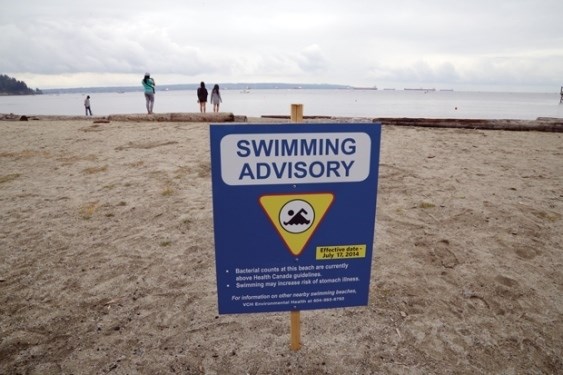Three of West Vancouver's popular beaches opened to swimming for the first time Thursday after weeks of residents being warned off because of high bacteria counts in the water.
Despite the recent relief at Ambleside, Dundarave and Sandy Cove, there's no denying it's been a long hot summer of unusual swimming beach closures for West Vancouver.
"We're getting a lot of questions from the public," said Dr. Mark Lysyshyn, medical health officer for the North Shore. "People are very unhappy."
So far, authorities still don't know what caused the spike in numbers of E. coli bacteria, which is sampled weekly at swimming beaches. Not that they haven't been looking.
After a sudden spike in coliform counts in mid-July, municipal staff ran dye tests in sewage lines that pass close to the beaches, to check for leaks - and found none. Staff also checked the Lions Gate sewage treatment plant and looked into the possibility of sewage leaking out through the storm sewers. None of that pointed to a problem.
Some people have speculated the initial spike in numbers - which sent counts climbing to more than 4,600 units of bacteria per 100 millilitres in one sample taken at Ambleside on July 18 and over 2,000 units in two Dundarave samples - may have been caused by a large ship dumping its sewage into Burrard Inlet.
It is illegal to dump waste within 200 kilometres of the shore, but enforcement by Transport Canada relies on spot checks of vessels. Lysyshyn said he's meeting with Transport Canada officials next week to discuss those regulations.
Other theories about the source of the bacteria range from wildlife feces being washed downhill to droppings from large flocks of Canada geese.
Peter Ross, director of the Vancouver Aquarium's ocean pollution research program, said there are tests that could narrow down the question.
Some other jurisdictions have used microbial source tracking - a set of relatively new tests - which can reveal what species the E. coli is coming from.
In one Seattle case, testing showed pollution widely thought to be coming from leaking septic fields was actually coming from dog poop.
In cases of multiple sources, however, those tests don't easily point to the main cause of contamination.
Lysyshyn said if tests came back indicating bacteria are from humans - as he suspects - it may not do much to solve the mystery.
Typically, said Ross, bacterial contamination that shows up in samples close to shore tends to come from the land, rather than the water.
When temperatures rise, warm ocean water rises to the surface and stays there, said Ross. That warm layer of water is more vulnerable to any contamination.
While authorities test weekly for E. coli, that bacteria is not necessarily what health officials are worried about. Some strains of E. coli can be dangerous, while others are more benign. Scientists assume, however, that higher concentrations of E. coli mean that viruses like hepatitis, parasites and other more serious pathogens could also be present in the water.
Some of those can also potentially pose a risk to marine life.
In California, for instance, a third of all disease-caused death in wild sea otters is now caused by toxoplasmosis - an organism carried by domestic house cats. One possible culprit? "The propensity of some home owners to buy flushable kitty litter," said Ross.
Despite warnings from lifeguards, not everyone heeded the advice to stay out of the water, said Jeff McDonald, spokesman for the District of West Vancouver.
He acknowledged that for many residents, however, the closures have been frustrating. "We've had a beautiful summer and people naturally want to spend time on the beaches," he said. "When you spend time on the beaches it's pretty natural to want to spend time in the water."



